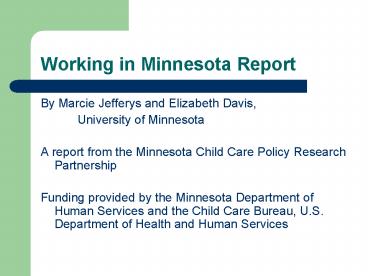Working in Minnesota Report - PowerPoint PPT Presentation
1 / 20
Title:
Working in Minnesota Report
Description:
8,166 jobs with industry codes. 7,156 jobs with wage and hour information ... Uses NAICS. Additional analyses (vacancies, payback) ... – PowerPoint PPT presentation
Number of Views:35
Avg rating:3.0/5.0
Title: Working in Minnesota Report
1
Working in Minnesota Report
- By Marcie Jefferys and Elizabeth Davis,
- University of Minnesota
- A report from the Minnesota Child Care Policy
Research Partnership - Funding provided by the Minnesota Department of
Human Services and the Child Care Bureau, U.S.
Department of Health and Human Services
2
Where do Child Care Assistance Recipients Work?
- In which industries are they concentrated, and
what are the implications of their employment
patterns for the recipients, employers and
government?
3
Prior Where They Work Studies
- Other states (FL, OR, AL, CA) and earlier Ramsey
Co. study - Concentrated in retail trade (esp. grocery stores
fast food restaurants) and services (esp. temp
help health care)
4
Data
- CCAP recipients SSN matched with wage and hour UI
data and ES-202 industry classification) - 8,166 jobs with industry codes
- 7,156 jobs with wage and hour information
5
Major CCAP Employing Industries All Four Counties
6
CCAP Compared to the Total Workforce
7
Results Similar to Other States (SICS)
8
CCAP job patterns are related to local economic
needs
9
CCAP parents are working in industries with most
job vacancies
10
Other Earnings Hours Findings
- CCAP jobs are less than full-time (esp.
administrative and support, retail trade, and
accommodation and food services) - CCAP jobs pay less than FPL (esp. administrative
and support, retail trade, and accommodation and
food services) - Similar across counties
11
Average Total Workforce CCAP Weekly Earnings
High Wage
12
Average Total Workforce CCAP Weekly Earnings
Low Wage
13
Employment Patterns Vary by Type of Child Care
Assistance
- MFIP recipients are most concentrated in three
low-wage industries admin. support, retail
trade and accommodation and food services
14
Child care provider payments
- Substantial differences across industries in the
extent to which a dollar invested in child care
results in earnings. - Child care payments approximately the same across
industries - Earnings vary greatly across industries
- Define payback ratio parent earnings divided
by CCAP provider payments
15
Hennepin County
16
I. Conclusions
- 150 M (est.) spent in MN. In 2001 for recipients
working in four industries - For some employers, the government is paying
nearly as much for their employees child care as
the employers are paying them in wages - Industries with chronic labor shortages due to
low wages have the most CCAP-supported employees - 7,500 (est.) additional workers in state because
of CCAP - Unlikely that the size of the CCAP supported
workforce is enough to exert downward pressure on
wages
17
II. Conclusions
- CCAP recipients are not generally working in jobs
that will make them less dependent on public
subsidies over time - Government investment results in higher payback
(recipient earnings) in some industries, but this
data are not tracked by the program - CCAP is somewhat responsive to local economic
conditions and may be helping to address a major
challenge facing the state labor shortages, and
is less costly than some other economic
development tools - CCAP represents a significant public investment,
but need still is not met
18
III. Conclusion
- In both the short and long term, CCAP recipients
(especially MFIP) will find it more difficult to
become financially self-sufficient through work
experience alone. - Industry personnel practices and internal
barriers to upper mobility, as well as low-wages,
challenge their ability to move upward,
regardless of individual characteristics which
may effect their employment options.
19
Limitations and Contributions
- Cross-sectional, not longitudinal, data
- Data characteristics (e.g., wage and hour data)
- Lack of data on recipient characteristics
- Human capital
- Race, sex, age
- Confirms earlier studies
- Uses NAICS
- Additional analyses (vacancies, payback)
- Relates results to labor market studies in other
fields
20
Suggestions for Future Research
- Examine the cumulative effect of work support
programs - Look at trends in child care assistance over
time, in economic context - Longitudinal research to determine what factors
lead to upward movement for recipients - More research on employers needs and
perspectives regarding the program

